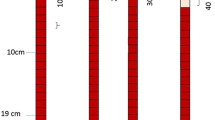Abstract
The Kynch theory of hindered sedimentation is used to investigate all possible modes of operation of a continuous flow gravitational settling chamber. The investigation is then extended to centrifugal sedimentation. An application to blood cell separation is suggested.
Similar content being viewed by others
References
Fitch, E. B. Flow path effect on sedimentation,Sewage and Industrial Wastes 1956,28, 1–9.
Hassett, N. J. Design and operation of continuous thickeners.The Industrial Chemist 1958a,34, 116–120; 1958b,34, 169–172; 1958c,34, 489–494.
Hawksley, P. G. W. The effect of concentration on the settling of suspensions and flow through porous media. InSome Aspects of Fluid Flow. London: Edward Arnold & Co., 1951.
Jernqvist, A. Experimental and theoretical studies of thickeners.Svensk Papperstiding Stockholm 1965a,68, 506–511; 1965b,68, 545–548; 1965c,68, 578–582; 1966,69, 395–398.
Kellogg, R. W. Flow model investigation: NCI-IBM blood cell separator. International Business Machines Systems Development Division Technical Report TR 01.1219, November 3, 1969.
Kynch, G. J. A theory of sedimentation.Transactions of the Faraday Society 1952,48, 166–176.
Moncrieff, A. G. Theory of thickener design based on batch sedimentation tests.Transactions of the Institution of Mining and Metallurgy 1963–64,73, 729–759.
Remenyik, C. J., Sartory, W. K., Brantley, J. N., and Breillatt, J. P. Continuous flow rotors for leucocyte separation: Theory, design, and experimental observations. Paper presented at International Symposium on Leucocyte Separation and Transfusion, London, September 1974.
Robins, W. H. M. The theory of the design and operation of settling tanks.Transactions of the Institution of Chemical Engineers 1964,42, T158-T163.
Sartory, W. K. Prediction of concentration profiles during erythrocyte sedimentation by a hindered settling model.Biorheology 1974,11, 253–264.
Schnittger, J. R. Integrated theory of separation for bulk centrifuges.Industrial and Engineering Chemistry Process Design and Development 1970,9, 407–413.
Talmage, W. P., and Fitch, E. B. Determining thickener unit areas.Industrial and Engineering Chemistry 1955,47, 38–45.
Author information
Authors and Affiliations
Additional information
NIH-AEC Molecular Anatomy Program is jointly sponsored by the National Cancer Institute, the National Institute of General Medical Sciences, the National Institute of Allergy and Infectious Diseases, and the U. S. Atomic Energy Commission. The Oak Ridge National Laboratory is operated by Union Carbide Corporation for the U. S. Atomic Energy Commission.
Rights and permissions
About this article
Cite this article
Sartory, W.K. Modes of operation in continuous flow sedimentation of erythrocytes. Ann Biomed Eng 3, 13–33 (1975). https://doi.org/10.1007/BF02584486
Received:
Issue Date:
DOI: https://doi.org/10.1007/BF02584486




